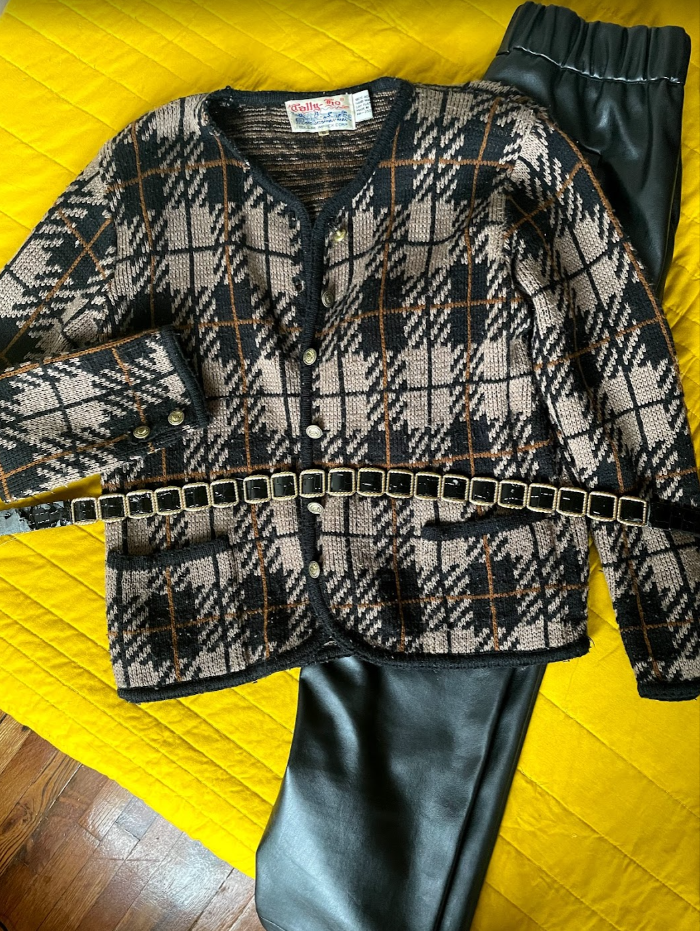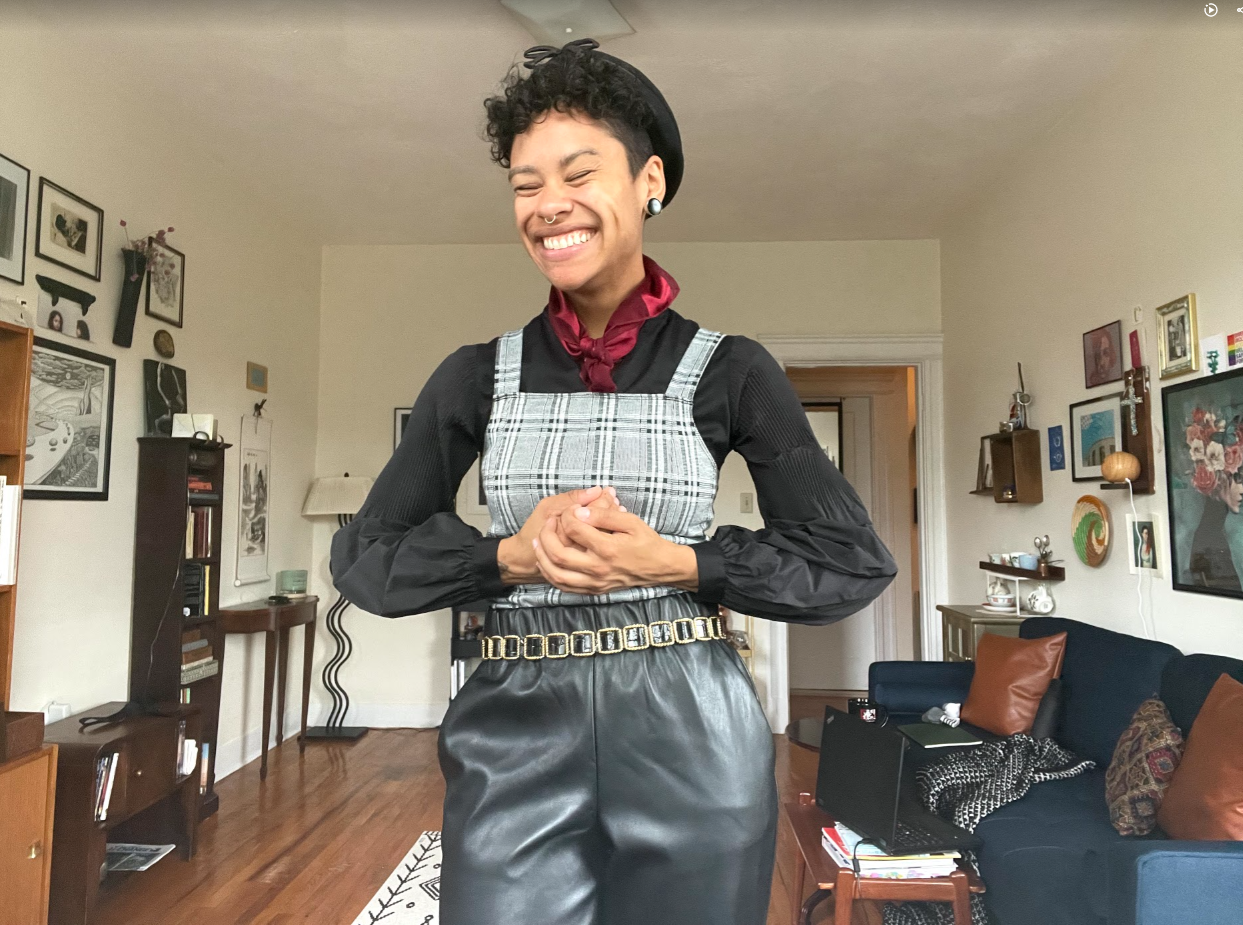The Restless One Who Dons Her Courage With a Belt
The social layers of fashion.
I had a presentation one Monday morning at work, a brief share of what I and a co-worker had been working on for a current project. It was casual, a 5 minute conversation from the comfort of my seat, sun-filtered and spotted with laughter, but even to 30 people I knew, speaking still plagued me like a nightmare from the moment I was asked to do it.
The frustration brewed within me, began to wear on me and I draped it like a garb I resentfully couldn’t take off. Despite attempted affirmations, I was stuck, until something was handed to me. A belt. Black patent faux-alligator-esque leather weaved through chained gold buckles. It was a gift from my friend Rosemary. She gave me the loveliest encouragement when I told her about the feared Monday. Sadly, I knew even as she spoke the words, I could not receive them, they would not rest on my shoulders like the draped frustration. Then, when she handed me the belt…elation. The trepid brewing shifted and I immediately began to scour my wardrobe for what I might create with this belt. I’d be wearing it on Monday.
This isn’t the first instance I was emboldened by an article of fashion I put on. In photographs or walk-by glances in windows, I know my mood has been altered by what I wear. The fact that a belt could lift my spirits enough to help me do my job felt ridiculous. Yet it also felt so natural, to feel that elation, to feel relief from anxiety.
So, I explored the idea a little more.
fashion as perception
“we think not just with our brains, but with our bodies” -Dr. Adam D. Galinsky
Enclothed cognition.
Photo by Hush Naidoo Jade Photography on Unsplash
That shift in mood that I experienced wasn’t just some flippant idea, but some genuine synapse work in my brain. Studies have found that clothing goes beyond a social construct, it has honest effects on cognitive processes. Influenced by societal norms or cemented associations, how we dress directly affects the way we function and perceive in the world. A white lab coat, for example, often creates the impression of intelligence because it is associated with professions in the Sciences, fields that require expertise. Interestingly, in a study conducted by Dr. Adam D Galinsky, that impression is going to be strongest when you see the coat on someone, or when you yourself wear one. A lab coat hanging from a hook holds only a fraction of the influence as to when it is worn.
We form judgments of people by their presentation, which comes with very complex, beautiful, and problematic consequences. Presentation can spark cruel treatment and condemnation as powerfully as it can create connection and solidarity with others. I see a person donned in an all pink sweat suit, white Nikes, and their hair in full platinum dreads and I am immediately inspired. Their choices to create that look signify a creative spirit about them, and that sparks my creative spirit, in turn.
I am reminded that clothes signify the place we want to be in socially, that sense of identity exists in a larger framework. I want to have the confidence to wear a pink sweat suit, white Nikes, and turn my curls platinum. It is a source of personal acceptance, a peace of mind that fashion is a reflection of truth and hopes. All of that affects our mental state and provides a sustenance.
fashion as sustenance
“Personal style is basically just illustrating what’s on the inside, outwardly” - Khadijat Oseni
I am at home in a thrift shop where vintage or last season finds dominate the racks. My outfits reflect eras weaved together, successfully and not, where individual stories combine into a unique narrative. The colors, patterns, and cuts that compliment my body give me joy and confidence. The opposite has just as strong an effect. If I am wearing something I am dissatisfied with, my mood is easily affected — hyper aware of every adjustment of that shirt that just won’t stay tucked or my outfit that attracts uncomfortable attention — my day of cognitive dissonance edges closer to coming undone.
Photo by Robert Maxwell for Real Simple Magazine
Perhaps the difference between the consoling words and this black patent belt effect is that those words share the same space as the demoralizing ones. The sheer volume of the not enough can barely be touched by any encouragement. But the physicality of the belt, putting it on, is like shedding those words into silence, and owning a decision of confidence. Because I find joy in clothes that reflect my creativity, to craft an outfit is in itself an act of confidence. The belt is interesting and eye catching, my references from fashion magazines of poised women in stride to New York fashion week and old photos of my powerhouse grandmothers. These stimulate certain senses, and my sense of self is drawn to then create eye catching interest. That image, which may exist only in my head and may never be vocalized or affirmed by another person, is strong enough to quiet that dominating voice of anxiety. Writer Khadijat Oseni’s words remind me that there are stronger narratives swaying and proving my path than just anxiety, and the clothes that inspire me, embody that beyond my body.
Anxiety’s power is swayed by what I choose to put on.
fashion as claim
“And then I married myself in a metallic blazer” -Gabrielle Bates
I saw this Instagram post of a beautiful ivy wreathed veranda, and a poet, Gabrielle Bates, in a sparkled structured blazer, standing beneath it. I saw it like a proclamation, impressed not only by the sleek appeal of the blazer, but by the message behind it. Considering perception again, you could read into it a number of ways, finding it as a bold claim of female independence or as a humorous joke. I prefer the former with a small dose of the latter. That is what fashion can offer, inspiration and relief. When I decided to dress up after admiring this post, I explored my closet for my version of marrying myself in a metallic blazer. I felt a joyful empowerment. It was a small act of uplifting myself, using the clothes to embody an idea, one that I could feel encouraged to speak and live out.
I’ve heard people say clothes have no meaning, they only serve a functional purpose, and anything beyond it is pointless or vain. I can respect that opinion, though I am saddened by it. Fashion is an intrinsic part of human expression that communicates so much, and always has.
Photo by Keystone/Getty Imaages
Take the symbolism of the waistcoat, for example. A Refinery29 article, written by Rosalind Jana, references the way masculinity was initially the modality of the waistcoat, but then it held “particular significant meaning in queer circles, where menswear [hadn’t] just figured as a reclamation of power but a visible encoding of difference – and desire”. She goes on to list numerous writers, actors, artists who over centuries took this piece and made it something of their own. It is not just about tailored ware, but about female and gender non-conforming voices reclaiming autonomy by wearing this typically patriarchal clothing. How we walk the world, how we express ourselves in it, can be welcomed and denied. We can be judged and criticized by our clothes for not filling the right role or embodying a dated one.
fashion as harm
“my clothes do not determine my consent” —odyssey online
This section could be a post all its own. I can’t talk about courage from fashion without delving a little further into how fashion can harm.
There are many ways that clothing causes divisiveness, judgment, even fear. It can be loud or subtle, colors and symbols to push agendas and messages. A woman wearing a low cut top is seen as suggestive and possibly an indication that if ever mistreated or harmed, she is responsible because of it. In the high fashion brands, deep historical messages are missed by their choice of color and cut. Back in 2019, Gucci released a black jumper that extended up to the nose of a white model’s face, a cutout outlined with large red lips, that was painfully reminiscent of black face. Clothing isn’t just threads or a function of survival, it is tool to speak and express.
Photo By Gucci/Spring
With both the dark and empowering examples in history, there is a challenging reality in different cultures adopting each others expressions. There is a risk of cultural appropriation that trickles into the psyche of the masses and leaves those groups of people who created the brilliance, under-represented.
Currently isolated in quarantine, fashion has become primarily a joy just for myself. One day I was inspired to create a Gothic look. A broad shouldered, all black detailed dress, dark red lips, gray shaded eyes, my mother’s red glass cross necklace, and black platform boots. I felt badass. But, in writing this post, I realized I knew so little of goth culture, and isn’t that ignorance an essence of appropriation? I studied it more, and came to find, the culture I knew little of, had questions of appropriation. The 19th century Victorian European melancholic attitudes that inspired the likes of Marilyn Manson have actually had a further source to pull from - the African Diaspora.
I think there is something great in appreciating the beauty of another culture, exploring it’s expression in your own life, but it must be with a pursuance of understanding, knowledge, and sensitivity. And, too, respecting when some of those fashion forms have too dark an association. I want to know what owning this signature style looks like, and whether it be goth or another culture/sub-culture I am less familiar with, I will do my best to communicate my appreciation without assuming I own it or its history, as an identity.
Fashion as my life
My belt, my life. It comes down to choice. Clothing has elicited beliefs I hold of myself. There is power in that. My moment of anxiety soothed by a belt is a small thing, but it accomplished a challenge I could then do more internal work on. If nothing else, this belt is sexy. If something more, I gained insight into my own prowess, ignorance, and further hopes for myself. And I did just fine on my presentation.
.Kels.





